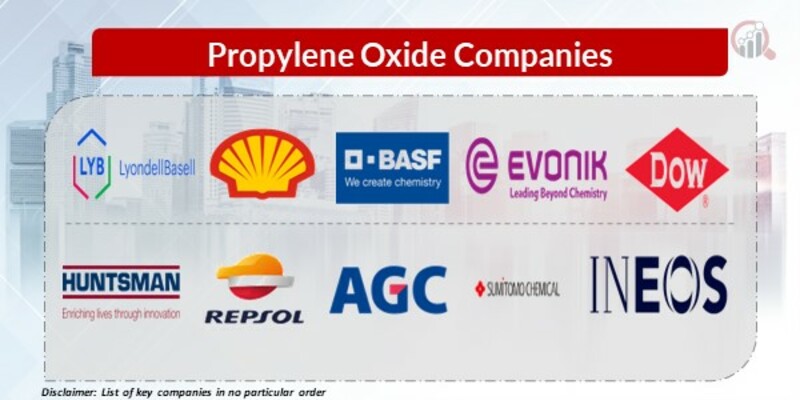Top Industry Leaders in the Propylene Oxide Market

Propylene oxide, a crucial chemical intermediate for various downstream products, is witnessing a dynamic and competitive landscape. With a projected market size exceeding USD 24 billion by 2027 and a steady CAGR of 5%, the battle for market share intensifies. To navigate this dynamic terrain, let's delve into the key strategies, driving factors, and recent developments shaping the propylene oxide market.
Strategies Adopted by Market Players:
-
R&D Prowess: Leading players like BASF and LyondellBasell are heavily investing in research and development to optimize production processes, enhance efficiency, and develop bio-based propylene oxide alternatives. This focus on sustainability is crucial for long-term market success. -
Geographic Expansion: Recognizing the potential of emerging economies, companies like INEOS Oxide and Dow are expanding their production capacities in Asia and the Middle East, capitalizing on the rising demand for propylene oxide derivatives in these regions. -
Vertical Integration: To secure feedstock and gain cost advantages, major players like Shell and Sumitomo Chemical are integrating their propylene oxide production with upstream propylene facilities. This vertical integration offers greater control over the supply chain and cost optimization. -
Product Diversification: To cater to diverse downstream applications, companies are expanding their product portfolios by offering specialty propylene oxide grades with unique properties. This diversification caters to specific needs and helps secure customer loyalty. -
Digitalization and Automation: Embracing Industry 4.0 technologies, leading players are implementing automation and digital solutions to optimize production processes, improve operational efficiency, and enhance safety.
Factors Influencing Market Share:
-
Production Cost and Efficiency: The cost-effectiveness of production processes plays a significant role in determining market share. Companies with access to low-cost feedstock and efficient production technologies hold an advantage. -
Geographical Location: Proximity to key consumer markets and efficient transportation infrastructure significantly impact market share. Players strategically located near major demand centers have a logistical advantage. -
Product Quality and Consistency: Stringent quality standards and consistent product performance are crucial for customer satisfaction and market share retention. Leading players invest heavily in quality control measures and process optimization. -
Regulatory Landscape: Stringent environmental regulations and safety norms can impact production costs and market access. Companies with a strong focus on compliance and sustainability gain an edge. -
Downstream Demand Trends: The growth of key downstream industries like polyurethanes, propylene glycols, and polyetheramines directly influences propylene oxide demand. Understanding and catering to these trends is crucial for market share gains.
Key Companies in the Propylene Oxides Market includes:
- Lyondellbasell Industries (Netherlands)
- Shell plc (United Kingdom)
- BASF SE (Germany)
- Evonik Industries (Germany)
- Dow Chemical Company (United States)
- Huntsman Corporation (United States)
- Repsol S.A. (Spain)
- Asahi Glass Co. Ltd. (Japan)
- Sumitomo Chemical Company (United Kingdom)
- INEOS Group (Japan)
- Balchem Corporation (United States)
Recent Developments:
November 2022: LyondellBasell announced the plan for expanding propylene production capacity at its Channelview Complex in Houston, Texas. A new propylene factory would be built utilizing the company’s current technology to convert ethylene into propylene for the manufacturing of polypropylene and propylene oxide.
January 2021, LyondellBasell, one of the world's largest plastics, chemicals, and refining companies, and China Petroleum & Chemical Corporation (Sinopec), one of China's largest integrated energy companies, announced the signing of a 50:50 joint venture (JV) to produce propylene oxide (PO) and styrene monomer (SM) in the Chinese market.
April 2021: Shell Nanhai B.V. (Shell) and CNOOC Oil & Petrochemicals Co., Ltd (CNOOC) announced the launch of new units in their 50:50 joint venture, to deliver critical petrochemicals to the Chinese market. The new unit is China's largest of its kind, capable of generating up to 630,000 tonnes of styrene monomer and 300,000 tonnes of propylene oxide per year. These compounds are found in a variety of products ranging from home appliances to packaging and computers.









